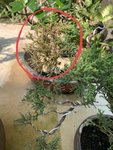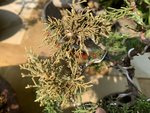walton1993
Seedling
- Messages
- 22
- Reaction score
- 8
Hi all, I’m new to bonsai and recently purchased a Juniper.
It’s been about 2-3 weeks since I purchased the tree and a section of the foliage is starting to turn grey.
Does anyone know what could be causing this and the steps I should take to reverse the problem? Pictures are attached.
I don’t know if the soil mix is the issue but it was fine at the nursery. I live in Indonesia which has a tropical climate.
Any advice is appreciated.
Best,
W
It’s been about 2-3 weeks since I purchased the tree and a section of the foliage is starting to turn grey.
Does anyone know what could be causing this and the steps I should take to reverse the problem? Pictures are attached.
I don’t know if the soil mix is the issue but it was fine at the nursery. I live in Indonesia which has a tropical climate.
Any advice is appreciated.
Best,
W




